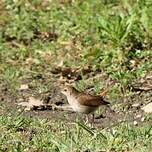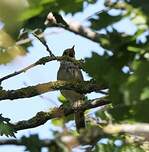Common Nightingale
Luscinia megarhynchos - Rossignol philomèle
Identification
The Common Nightingale is quite a plump bird, larger than a robin, with a similar build. It is a quiet bird, and were it not for its resonant singing in spring, it could quite easily be overlooked. It is also quite discreet in its plumage, a warm reddish-brown on top. The reddest parts are the crown, wings, rump, uppertail, and tail, the last resembling a redstart. A grey tinge is common around the neck and sides of the head. The large, dark eye is surrounded by a readily noticeable white-cream eye-ring. The beak is two-toned, brown above and two-thirds pink below. The underparts are whitish, with a noticeable brownish-red band on the chest and flanks. The undertail coverts are creamish-red. The legs are robust and brownish-pink. Like all young flycatchers, young nightingales have spotted plumage. The speckles are creamish-red on it, and allow it to be easily distinguished from the adult. 3 subspecies are described. The reddest is the western type megarhynchos subspecies found in Europe. The eastern golzi subspecies has a less warm, more grey, plumage.
Subspecific information 3 subspecies
- Luscinia megarhynchos megarhynchos (w and c Europe to c Turkey and south to Jordan)
- Luscinia megarhynchos africana (e Turkey, the Caucasus and n and sw Iran)
- Luscinia megarhynchos golzii (e Iran to Kazakhstan, sw Mongolia and nw China)
Foreign names
- Rossignol philomèle,
- Ruiseñor común,
- rouxinol-meridional,
- Nachtigall,
- fülemüle,
- Nachtegaal,
- Usignolo,
- sydnäktergal,
- Sørnattergal,
- slávik obyčajný,
- slavík obecný,
- Sydlig Nattergal,
- etelänsatakieli,
- rossinyol comú,
- Næturgali,
- słowik rdzawy,
- rietumu lakstīgala,
- slavec,
- Южный соловей,
- サヨナキドリ,
- 新疆歌鸲,
- sydnäktergal,
- 新疆歌鴝,
Voice song and call
The Common Nightingale is renowned for its song, one of the most beautiful in the regional repertoire, and it is not stingy with it. It sings day and night, from its arrival in the second decade of April until June, but its singing becomes more scarce when there are mouths to feed at the nest. Its song is loud and varied. Its power evokes that of a Song Thrush. It is untranscribable, and the best way to get an idea of it is to listen to it online on the xeno-canto website. It can only be confused with that of its eastern cousin, the European Reed Warbler. It has two main calls. The alarm call is an emphatic hiit or huit that evokes that of a White-fronted Redstart but more powerful. This call is often accompanied by a low tac. The other call, emitted on the nesting territory, is like a dry creaking sound with a low tone, unmistakable.
Habitat
The Common Nightingale is not a woodland bird. It is absent from mature forests, with the exception of riparian forest with dense undergrowth suitable for it.
Behaviour character trait
The Common Nightingale is a thrush. It spends its time on the ground in dense thickets where it can hide.
Its singing makes it easy to identify territorial males. Indeed, a singing male is typically only as high as a bush, but never at the top, and can stay in one place for a long time singing. With a bit of looking around, it can be found and observed at leisure. You can then note its upright posture, swollen throat due to singing, and drooping tail. However, when it is active on the ground, it straightens its tail at a 90° angle and can be compared to a large wren. It is a great migratory bird, spending its boreal winters south of the Sahara. Its long wings are a testament to that. The first migrants, generally males, come back a bit early in April and immediately show possession of their territory through singing. The nightingale is one of the few passerines of ours to regularly sing at night. It makes you wonder when males can rest, since they are also quite vocal during the day. Its post-nuptial migration occurs very discreetly at the end of summer. The only sounds are huit it makes during stopping points, indicating that it is passing through.Flight
Dietfeeding habits
Reproduction nesting
The Common Nightingale can raise two brood in one season, the first in April-May and the second in late May and June.
The female can brood the second clutch while the male finishes taking care of the young from the first brood. The nest is built low in the vegetation, most often less than 50 cm in height, at the foot of a dense bush, in a herbaceous tuft, well hidden. It is made of grass and leaves assembled quite loosely. Only the internal cup, the female's work, is quite well done. The latter lays 4 or 5 olive eggs tinted with reddish and like glossy. The incubation lasts 13 days and the young have their full plumage after 11 days but they do not become independent until about the age of one month.Geographic range
Common Nightingale is an Eurasian species that occupies a continuous geographical band from the Atlantic Ocean to the west of Mongolia, centering on temperate Europe and western Asia at the same latitudes. In the north, only southern England is occupied, but not Scandinavia. In the south it occupies the Maghreb. The subspecies type megarhynchos is distributed in the north of Africa, western Europe and central Europe up to the center of Turkey and south up to Lebanon. The ssp africana occupies the east of Turkey, the Caucasus and a northwestern part of Iran. Finally, the ssp golzi is located from the east of Iran to the northwest of China passing through Kazakhstan and the west of Mongolia. The African wintering area is a continuous sub-Saharan band ranging from Senegal to the west to Ethiopia, Somalia and Kenya to the east, passing through countries that border the Gulf of Guinea, Nigeria and the Central African Republic.
Threats - protection
Sources of information
- IOC World Bird List (v14.2), Gill, F and D Donsker (Eds). 2024-04-18.
- Atlas des oiseaux de France métropolitaine. Nidification et présence hivernale. , Issa Nidal et Muller Y
- Les passereaux d'Europe, tome 1, P. Géroudet, M. Cuisin
- Avibase, Lepage Denis
- HBW Alive,
- xeno-canto, Sharing bird sounds from around the world,
Other sources of interest
 Specification sheet created on
10/07/2023 by Jean François
Specification sheet created on
10/07/2023 by Jean FrançoisTranslation by AI Oiseaux.net
© 1996-2025 Oiseaux.net
- Accipitriformes
- Aegotheliformes
- Anseriformes
- Apodiformes
- Apterygiformes
- Bucerotiformes
- Caprimulgiformes
- Cariamiformes
- Casuariiformes
- Charadriiformes
- Ciconiiformes
- Coliiformes
- Columbiformes
- Coraciiformes
- Cuculiformes
- Eurypygiformes
- Falconiformes
- Galliformes
- Gaviiformes
- Gruiformes
- Leptosomiformes
- Mesitornithiformes
- Musophagiformes
- Nyctibiiformes
- Opisthocomiformes
- Otidiformes
- Passeriformes
- Pelecaniformes
- Phaethontiformes
- Phoenicopteriformes
- Piciformes
- Podargiformes
- Podicipediformes
- Procellariiformes
- Psittaciformes
- Pterocliformes
- Rheiformes
- Sphenisciformes
- Steatornithiformes
- Strigiformes
- Struthioniformes
- Suliformes
- Tinamiformes
- Trogoniformes

































